Loo Bloos – Solving the problems of shipboard sanitation
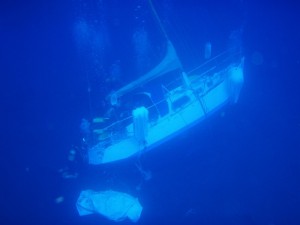
Picture the scene: You’re three days out from the Marquesas, on your way to Tahiti. The moon is almost full, and a silvery-white path leads all the way over the black sea to the edge of the world. A steady force five fills the belly of the mainsail, and the genny is also pulling nicely. There’s nothing needs doing – the wind vane is in control – and you can sit back and soak it all up. That’s what our friend Dave was doing. “What could be better than this?” he asked himself.
The answer came swiftly: “This, and a mug of coffee!”
Two steps, and he was down the companion ladder – and standing up to his ankles in water…! “Aaaargh!!!”
“I nearly died,” Dave said, recounting the story, years later. “It was just about the worst moment of the entire round the world trip. We were sinking! Or at least, I thought we were. There was water over the cabin-sole and I could hear it gushing in somewhere. I didn’t know where to start looking, or what to do. I was just about to begin tearing up the floorboards; I was just about to hit the button on the EPIRB. My heart was pounding… And then I remembered the loo.”
And, sure enough, it was the loo. The pan was full, and the mechanism was still sucking in the sea and pouring it over the rim. His daughter had left the seacock open again.
As seaworthy as a sieve
A siphoning sea toilet is a common experience, and although most of us get away with wet floorboards and a sinking feeling, anyone who neglects to close the seacocks before leaving the boat to her own devices risks returning to find her on the seabed. And after all, a loo pump is purpose designed to suck – so who can we blame but ourselves?
When you think about it, it’s a daft situation. We go to great lengths to ensure that our boats are ocean-proof, and then we drill holes in the bottom! Some boats are positively riddled with holes; one production-line fifty-footer that I helped to deliver had 50 seacocks – one for every foot of its length!
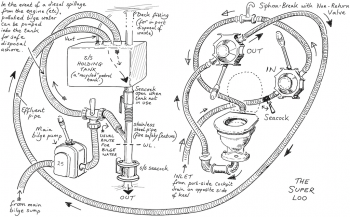
Well, when we built Mollymawk we aimed for minimum hull apertures, and our total count is 10. The log impeller and the echo-sounder transducer each require a hole; and then there are the rather larger openings for the rudder-stock and the prop-shaft. Since the engine is keel-cooled there’s no seawater inlet, but we do, of course, have an exhaust. It’s situated a few inches above the waterline, and – unlike most exhaust systems – it can be closed off, with a seacock. The five remaining holes are the cockpit drains, which are a vital feature in the cockpit of any ocean-going vessel, and the waste outlet.
The sink drain, the main bilge-pump, and the toilet all share the one waste outlet, the sink and the loo being plumbed in such a way that their content always passes through a holding tank, whilst the bilge water can be made to travel either via the tank or directly into the sea, depending on the circumstances. Secondary manual bilge pumps, an engine-drive bilge pump, and an electric bilge pump all exit directly into the cockpit, immediately above one of the drains. (This outlet is normally capped, so that a wave landing in the cockpit would not be able to drain into the boat.)
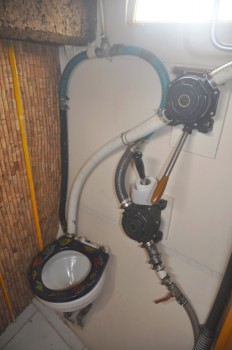
And what about the in-coming water for the loo, you ask? This and the salt water supply for the galley sink are both piped from the starboard for’ard cockpit drain, far from the polluting influence of the effluent emptying through the waste outlet on the opposite side of the keel.
Break the siphon
Of course, a minimum of hull apertures does not entirely remove the risk of the boat filling up with water and sinking. Duck had only five hull apertures, and yet she still sank. In her case, the water siphoned into the boat via the bilge pump. In order to prevent the sea toilet from siphoning in this same way you need a siphon break.
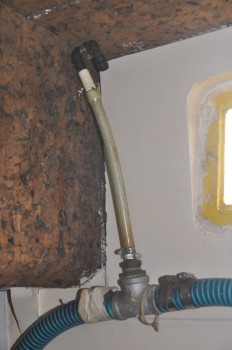
Aboard Mollymawk the inlet pipe for the loo is led up towards the deckhead, and at its highest point, well above sea-level, it is punctured by a second, very much smaller pipe which contains a one-way valve. Thus equipped, the inlet pipe can’t siphon. The worst that can happen if the seacock is left open is that water can be forced up the pipe and into the loo, but it can only do this one “whoosh” at a time, as the boat rolls. It can’t continue sucking.
As for the waste water – that can’t siphon back because the holding tank serves as a gigantic airlock. This makes the outlet seacock more or less superfluous, and we don’t close it unless we’re leaving the boat unattended over night.
Hubble bubble, toilet trouble
All in all we thought our lavatory system was pretty damn perfect. But it isn’t.
The first problem with our not-so-super loo is one which it shares with almost all sea toilets. The pump supplied with the unit was a piece of… er… Well, a piece of rubbish. It began to leak, spurting water around the cabin, only weeks after it was fitted. We replaced it with two Henderson Mark V bilge pumps, and all was well… until they blocked. If you’re only using your boat at the weekends an entire season might pass before the loo needs reaming out – provided Aunty Flo doesn’t stick a tampax or a wad of kitchen paper down its orifice, all will be well – but when you’re living aboard, and the loo gets a lot of use, its arteries quickly become furred with scale.
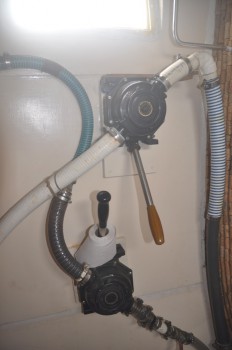
The second problem concerns our holding tank. It started its life as a fuel tank aboard another vessel. Most of our boat is recycled, including the rigging wire, our first set of sails, the engine, the steering system, the stainless steel for the watertanks, much of the woodwork, some of the steel, all of the bilge pumps… and the loo. The fact that the tank was pre-used was not the problem; the problem was that it was made of stainless steel and, unbeknownst to us at the time, stainless steel is entirely unsuited for use as a holding tank. So far as we can recall the tank has never been required to hold anything especially corrosive – nothing more corrosive than a good curry, anyway – but despite this it became porous. The welds were fine. The content simply ate straight through the metal!
The solution was to invest in a plastic tank, and we eventually found one which might have been custom made for the job. It was in the local junk shop and it cost less than twenty quid. However, this is not the end of the tale, for when we came to switch the tanks we found that the stainless steel flange joining the down-pipe to the stainless steel seacock was badly corroded. So badly corroded, indeed, that the mate immediately started to look for a suitable place to haul out, and the skipper dropped what he was doing and made some more soft-wood plugs – just to be on the safe side.
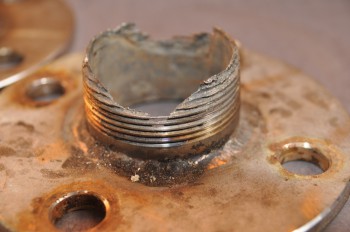
Well, if that’s what the flange looks like then presumably the seacock looks much the same. (Just in case you were wondering – no, they weren’t second hand; and yes, they are made of 316L.) Evidently, seawater + urea is not only inclined to cause scale but is also very acidic.
There has to be a better way
All things considered, a sea toilet is a crappy thing. In the ancient of days no boat builder would have dreamt of perforating the ship’s hull below the waterline. Can you imagine the Vikings putting up with this kind of nonsense? They even hung their rudder over the back. And the same goes for Columbus – he didn’t make holes in the bottom of the Santa Maria – and nor did Slocum perforate his Spray. Such a thing would have been considered madness. Why jeopardise the whole boat, and our lives, too, for the sake of something so base? There has to be a better way to go about the business of evacuating our bowels.
Many are the folks who have come to the same conclusion, and the usual first resort is a chemical toilet. This has the advantage of qualifying as a holding tank, should you want to visit America or Turkey, or anywhere else where such a thing is obligatory, but it also has the disadvantage of smelling like a cesspit – which is what it is. The chemical that you put inside the tank is supposed to do away with the stink, but in my opinion it smells just as bad as poo. I know plenty of people who have opted for a chemical toilet but I know only one who likes it well enough to stick with the thing. This is Pete Hill, and even Pete has moved on. Whereas Badger was equipped with the usual “khemi kaze” (as Annie Hill called it in her book), Pete’s latest boat is fitted with a composting toilet.
Having regard for the perils and problems of a sea toilet and the drawbacks of the chemical kind, some long-term liveaboards give up all together. They block up the hole, ditch the smelly alternative, and invest in a bucket. Our Turkish friends, Osman and Sibyl, bought two buckets, one for him and the other for her. (Perhaps it’s a Muslim thing?)
If you’re male you might even be tempted to think that the sea is a perfectly adequate latrine, and the only waste closet that you need. Another friend was once the proud owner of a beautiful Edwardian yacht – a veritable museum piece – and being keen to keep her looking completely traditional, both inside and out, he chose to ignore the Lavac which had been fitted by a former, less fastidious owner. His wife wouldn’t let him throw it out, but when she was not aboard Richard refused to acknowledge its existence; and he also refused to turn on the seacocks.
The facilities, for female guests, consisted of a small margarine tub. This, one was required to employ whilst squatting in the foc’sle (alongside the Lavac); and then one had to carefully stand up, clasping the brim-full tub, poke one’s head out of the forehatch, and aim to lob the content overboard. All this while the boat bounded along, possibly at an angle of 25°. If Richard only knew how close my three year old daughter came to emptying the contents of her bladder into his bilge…
So far as small children are concerned, buckets are only marginally better than margarine tubs. They’re fine in fair weather in the cockpit but their use in a marina or anchorage is an embarrassment; and then there’s the weather to consider. In the sort of conditions where oilskins are necessary, a bucket is a miserable alternative to the more usual arrangement. No one likes to be caught with their trousers down while there are waves landing on the deck. In heavy weather the bucket has to be taken below, and we pale (ho-ho) to think of the risks entailed in the undertaking which follows.
Did Eric the Red use a potty?
Surely there must be a better solution to the age old problem of answering the call of nature? Surely Sir Francis Drake didn’t squat on a pot while the Pelican heaved and rolled? Of course he didn’t. Just as modern beings seek to replicate the familiar flushing loo, so seafarers of old will have liked what they knew: Namely, the long-drop.
The most impressive long-drop that I’ve ever seen was on a castle wall in Germany, but similar devices existed everywhere – albeit generally without such scope for the projectile. Tacked onto the side of a mediaeval house, they were known as garderobes. Tacked onto the back of a junk or a caravel they probably had another name… but I don’t know it.
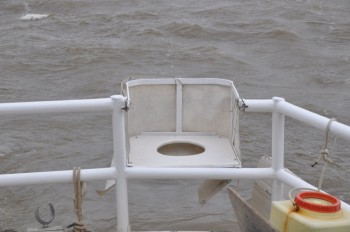
Some German friends abandoned their chemical toilet in favour of squatting at the stern – every morning we would see them, each in turn, hanging their tails over the sea – but you don’t have to be quite so indecorous, and you don’t have to suffer such discomfort. Our long-drop consists of a purpose built plywood seat which we fitted into the pushpit. Many modern boats have two such seats, one on either quarter, and all that is needed, in order to convert them to use as a commode, is a suitably sized hole. Our deluxe version also features a modesty curtain which wraps around the frame and conceals the nether regions. So, now the end-user can happily sit there, and any passers-by will assume that he is reading a book, or sipping coffee, or just admiring the scenery. The downside of this is that they sometimes stop for a chat.
Award for the Best Loo
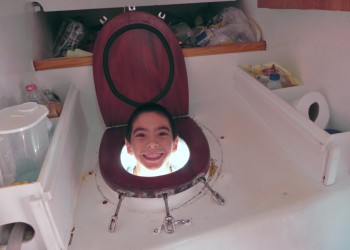
The ultimate toilet facility for those of a genteel disposition must be the arrangement built into our friends’ trimaran. Not so much a long-drop as a short-drop, this waste disposal unit is installed inside the boat, with the mess arriving in the water most discreetly, between the hulls. Mind you, it’s not so discreet for the artiste, because this is a bathroom with no doors, sited between the main cabin and the forepeak. Moreover, it can’t be used when the boat is flying along and kicking up spray, as trimarans are apt to do; at sea, the lid to the loo is clamped shut and the crew are back to using the bucket.
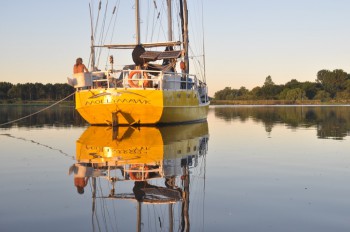
Some folks say that a long-drop is disgusting. “All that… stuff washing about in the anchorage,” they glower. Well, if you’re sharing the anchorage with other boats, “that stuff” is there anyway. The only difference is that if it passes through a toilet pump it gets macerated. If we’re anchored on a lee shore, or if there are people in the water astern of our boat, then we revert to the use of that confounded contraption with its valves and levers.
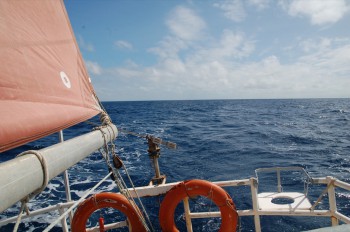
Yes, we still have the old sea-toilet. In West Africa the people just squat down and do their thing wherever and whenever they feel the need, but we aren’t so uninhibited; when the boat is alongside, we go below. At sea, however, the long-drop is simply the best throne in all the world. What other bathroom offers such a splendid view? Even when I’m not performing my ablutions I like to sit here and watch the boat sail herself.
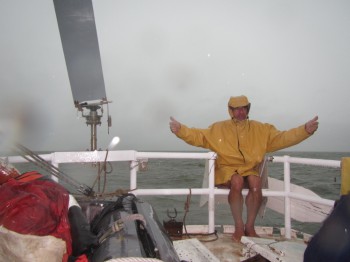 Of course, it’s not so great in heavy weather…
Of course, it’s not so great in heavy weather…
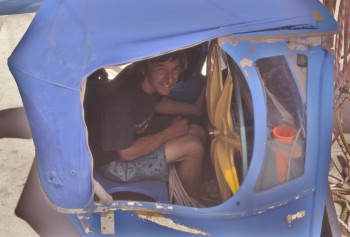
We’re proud of Mollymawk’s long-drop, and most of our guests seem happy to use it, but it isn’t the definitive loo. That award goes to a Wharram cat which we once knew. Its steering position was amidships, on the platform between the two hulls, and it was covered over with something resembling the back end of a 1930s Austin automobile. Inside this wonderfully eccentric little wheelhouse there was a hand-made wheel and a bench seat, and in the middle of the bench seat there was a hole. “That’s for when things get really bad,” said the owner. “It’s for when I’m shitting myself.”

Very interesting post! I have never thought about how the people in the past were going to toilet on the ships! Thanks for sharing!